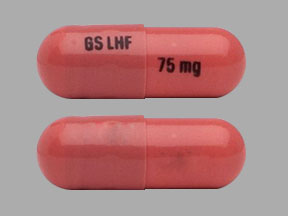Tafinlar Disease Interactions
There are 7 disease interactions with Tafinlar (dabrafenib).
Dabrafenib (applies to Tafinlar) cardiomyopathy
Moderate Potential Hazard, Moderate plausibility. Applicable conditions: Heart Disease
Cardiomyopathy (defined as a reduction in left ventricular ejection fraction [LVEF] at least 10% from baseline and below the institutional lower limit of normal [LLN]) has been reported with the use of dabrafenib in combination with trametinib. Caution should be exercised when using this drug in patients with heart problems. It is recommended to assess LVEF by echocardiogram or multigated acquisition (MUGA) scan before starting therapy, 1 month after starting, and then every 2 to 3 months while on treatment. Dabrafenib should be withheld for symptomatic cardiomyopathy or asymptomatic left ventricular dysfunction of greater than 20% from baseline that is below institutional LLN. Dabrafenib should resume at the same dose level upon recovery of cardiac function to at least the institutional LLN for LVEF and absolute decrease up to 10% compared to baseline.
Dabrafenib (applies to Tafinlar) diabetes
Moderate Potential Hazard, Moderate plausibility. Applicable conditions: Diabetes Mellitus
In clinical trials, patients with a history of diabetes who received dabrafenib required more intensive hypoglycemic therapy. Care should be exercised when using this drug in patients with preexisting diabetes or hyperglycemia. Serum glucose levels should be monitored at the start of therapy and as clinically indicated in these patients. Antihyperglycemic medications should be started or optimized as clinically indicated.
Dabrafenib (applies to Tafinlar) fever
Moderate Potential Hazard, Moderate plausibility. Applicable conditions: Infection - Bacterial/Fungal/Protozoal/Viral
Serious febrile reactions and fever of any severity complicated by rigors/chills, hypotension, dehydration, and/or renal failure have been observed with the use of dabrafenib. The incidence and severity of pyrexia are increased when this drug is administered in combination with trametinib compared with dabrafenib as a single agent. It is recommended to withhold therapy for temperature of 38C (100.4F) or higher; in case of recurrence, therapy can be interrupted at first symptom of pyrexia. Patients should be evaluated for signs/symptoms of infection, and it is recommended to monitor serum creatinine and other evidence of renal function during and after severe pyrexia. Antipyretics should be administered as secondary prophylaxis when resuming therapy for patients with prior episode of severe febrile reaction or fever associated with complications. Corticosteroids (e.g., prednisone 10 mg/day) should be administered for at least 5 days for second or subsequent pyrexia if temperature does not return to baseline within 3 days of pyrexia onset, or for pyrexia associated with complications, and there is no evidence of active infection. Upon resolution of pyrexia, dose reduction and/or permanent therapy discontinuation may be required.
Dabrafenib (applies to Tafinlar) G6PD deficiency
Moderate Potential Hazard, Moderate plausibility. Applicable conditions: G-6-PD Deficiency
Dabrafenib contains a sulfonamide moiety. Care should be exercised when using this drug in patients with glucose-6-phosphate dehydrogenase (G6PD) deficiency as it may increase the risk of hemolytic anemia. Patients with G6PD deficiency should be monitored for signs of hemolytic anemia while taking dabrafenib.
Dabrafenib (applies to Tafinlar) hemorrhage
Moderate Potential Hazard, Moderate plausibility. Applicable conditions: Bleeding
The use of dabrafenib may increase the chance of hemorrhagic events. Care should be exercised when using this drug in patients who have had bleeding problems or who plan to have surgery, dental, or other medical procedures. Dabrafenib should be permanently discontinued for all grade 4 hemorrhagic events and for any grade 3 hemorrhagic events that do not improve. Dabrafenib should be withheld for grade 3 hemorrhagic events; if improved, this drug should resume at the next lower dose level.
Dabrafenib (applies to Tafinlar) liver disease
Moderate Potential Hazard, Moderate plausibility.
Hepatic metabolism and biliary secretion are the primary routes of elimination of dabrafenib and its metabolites; thus, patients with moderate (bilirubin greater than 1.5 to 3 times the upper limit of normal [1.5 to 3 x ULN] and any AST) or severe (bilirubin greater than 3 to 10 x ULN and any AST) liver dysfunction may have increased exposure. An appropriate dosage has not been established for patients with moderate or severe liver dysfunction; care should be exercised when using dabrafenib in these patients. Dose adjustment is not recommended for patients with mild liver dysfunction (bilirubin up to ULN and AST greater than ULN or bilirubin greater than 1 to 1.5 x ULN and any AST).
Dabrafenib (applies to Tafinlar) skin toxicities
Moderate Potential Hazard, Moderate plausibility. Applicable conditions: Dermatitis - Drug-Induced
The use of dabrafenib may result in severe cutaneous adverse reactions (SCARs), including Stevens-Johnson syndrome and drug reaction with eosinophilia and systemic symptoms (DRESS), which can be life-threatening or fatal. Care should be exercised when using this drug in patients at risk of skin toxicities. Patients should be monitored for new or worsening serious skin reactions. Dabrafenib should be permanently discontinued for SCARs. For other skin toxicities, dabrafenib should be withheld for intolerable or severe skin toxicity and should resume at a lower dose upon improvement or recovery within 3 weeks. Dabrafenib should be permanently discontinued if skin toxicity has not improved within 3 weeks.
Switch to professional interaction data
Tafinlar drug interactions
There are 512 drug interactions with Tafinlar (dabrafenib).
Tafinlar alcohol/food interactions
There is 1 alcohol/food interaction with Tafinlar (dabrafenib).
More about Tafinlar (dabrafenib)
- Tafinlar consumer information
- Check interactions
- Compare alternatives
- Pricing & coupons
- Reviews (2)
- Drug images
- Side effects
- Dosage information
- During pregnancy
- FDA approval history
- Drug class: multikinase inhibitors
- Breastfeeding
- En español
Related treatment guides
Drug Interaction Classification
| Highly clinically significant. Avoid combinations; the risk of the interaction outweighs the benefit. | |
| Moderately clinically significant. Usually avoid combinations; use it only under special circumstances. | |
| Minimally clinically significant. Minimize risk; assess risk and consider an alternative drug, take steps to circumvent the interaction risk and/or institute a monitoring plan. | |
| No interaction information available. |
See also:
Further information
Always consult your healthcare provider to ensure the information displayed on this page applies to your personal circumstances.


